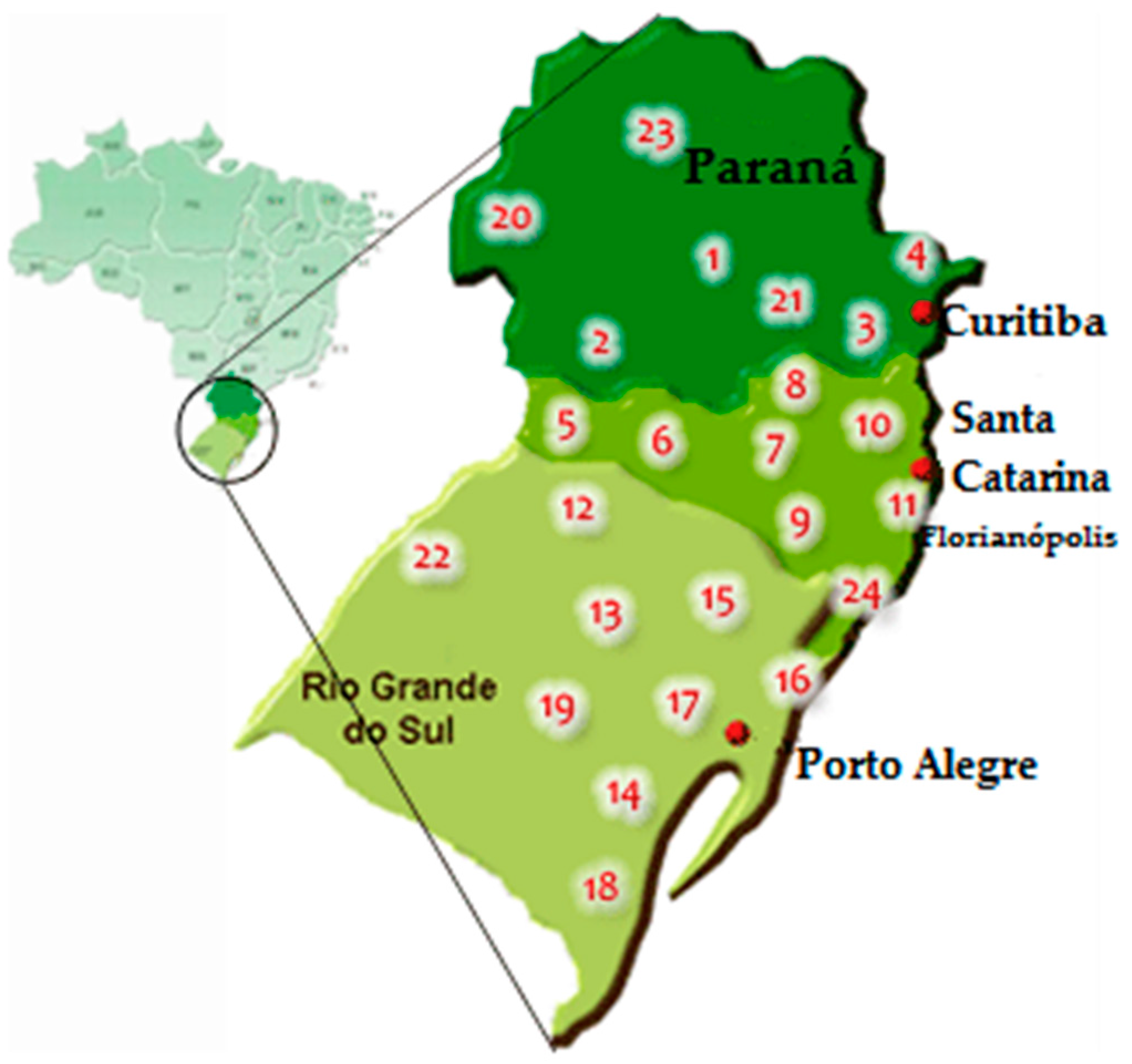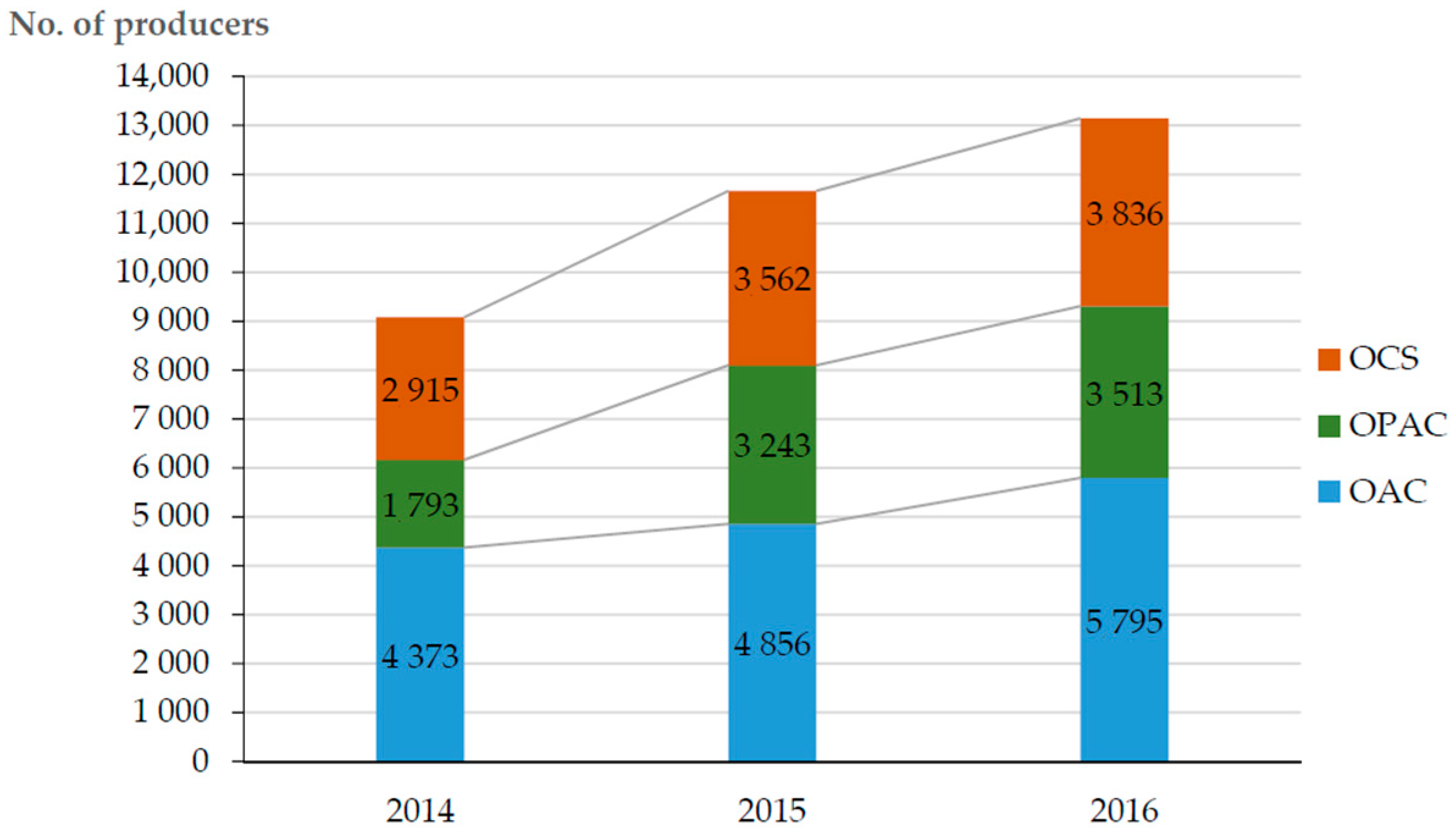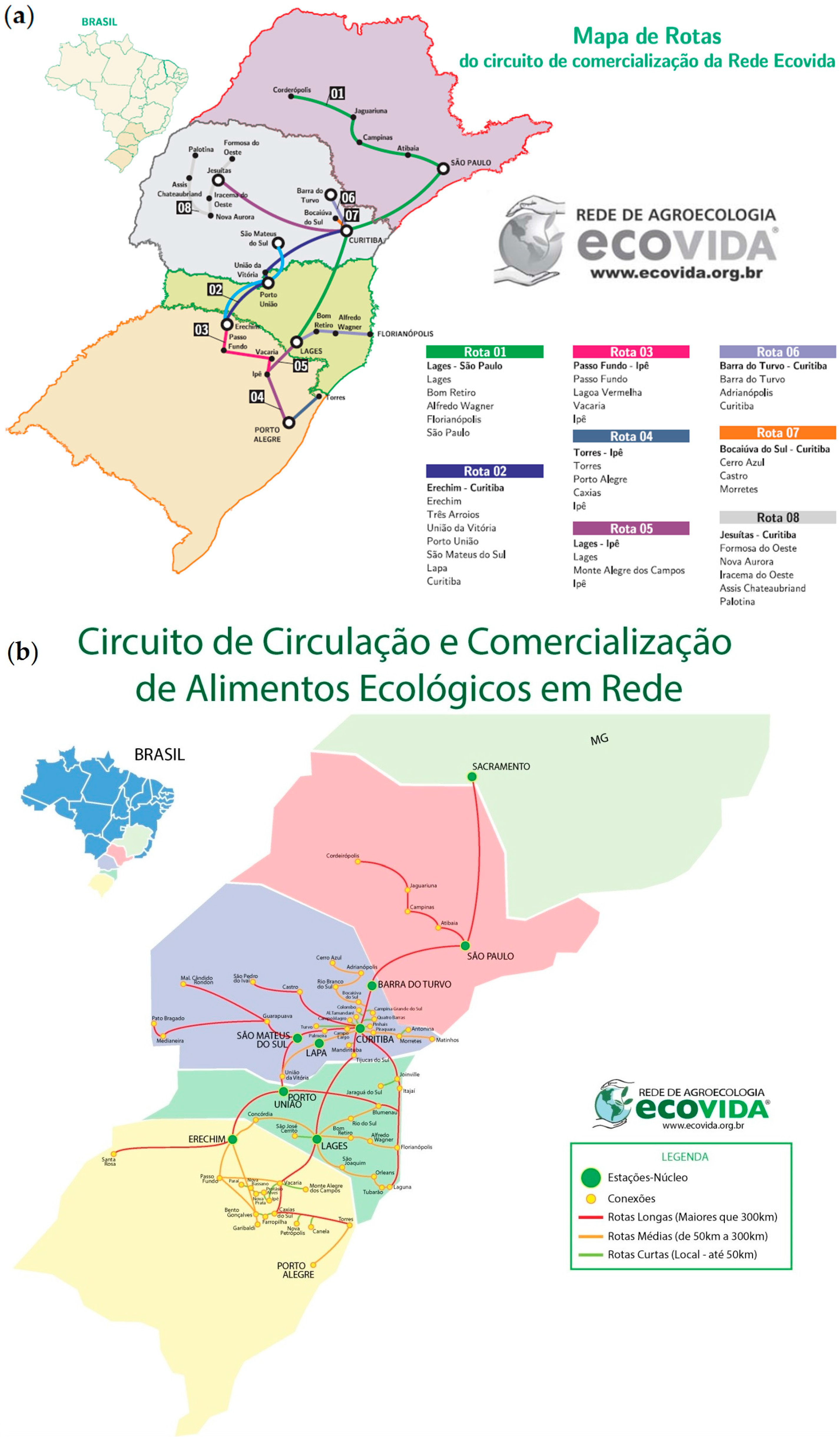Social Innovation and Sustainable Rural Development: The Case of a Brazilian Agroecology Network
Abstract
:1. Introduction
2. The Theoretical Framework: Social Innovation and Rural Development
3. The Case of Rede Ecovida de Agroecologia
3.1. Methodological Approach
3.2. History, Organization and Social Innovation
3.3. Functioning of Participatory Guarantee Systems (PGS)
- (1)
- Third-party certification, operated by an independent company, subject to Conformity Assessment Bodies (in Portuguese: Organismos de Avaliação da Conformidade, or OAC);
- (2)
- Participatory Guarantee Systems, operated by a Participatory Body for Conformity Assessment (in Portuguese: Organismos Participativos de Avaliação da Conformidade, or OPAC), under which Ecovida operates; and
- (3)
- Social Control Organizations (in Portuguese: Organização de Controle Social, or OCS), operated by local organizations, intended to be used only to sell products according to direct marketing strategies.
3.4. Social Set-Up of the Markets
4. Discussion and Concluding Remarks
Acknowledgments
Author Contributions
Conflicts of Interest
References
- Schumpeter, J.A. The Theory of Economic Development: An Inquiry into Profits, Capital, Credit, Interest and the Business Cycle; Opie, R., Ed.; Transaction Publishers: Piscataway, NJ, USA; London, UK, 2008. [Google Scholar]
- Murray, R.; Caulier, J.; Mulgan, G.G. Il Libro Bianco Sulla Innovazione Sociale. Available online: http://www.societing.org/wp-content/uploads/Open-Book.pdf (accessed on 9 September 2016).
- Neumeier, S. Why do social innovations in rural development matter and should they be considered more seriously in rural development research?—Proposal for a stronger focus on social innovations in rural development research. Sociol. Rural. 2012, 52, 48–69. [Google Scholar] [CrossRef]
- Caroli, M.G. Modelli ed Esperienze di Innovazione Sociale in Italia: Secondo Rapporto Sull’Innovazione Sociale; International Center for Research on Social Innovation (CERIIS): Milano, Italia, 2015. (In Italian) [Google Scholar]
- Bock, B.B. Rural marginalisation and the role of social innovation; A turn towards nexogenous development and rural reconnection. Sociol. Rural. 2016. [Google Scholar] [CrossRef]
- Furtado, A. Opções tecnológicas e desenvolvimento do terceiro mundo. In Desenvolvimento e Natureza: Estudos para Uma Sociedade Sustentável, 3rd ed.; Cavalcanti, C., Ed.; Cortez/Fundação Joaquim Nabuco: São Paulo, Brazil, 2001; pp. 256–275. [Google Scholar]
- Arend, M.; Cario, S.A.F.; Enderle, R. Instituições, inovações e desenvolvimento econômico. In Pesquisa & Debate. Revista do Programa de Estudos Pós-Graduados em Economia Política; Departamento de Economia da Pontifícia Universidade Católica de São Paulo: São Paulo, Brasil, 2012; Volume 23, pp. 110–133. [Google Scholar]
- United Nations. Framework Convention of Climate Change. Paris Agreement. Available online: http://unfccc.int/resource/docs/2015/cop21/eng/l09r01.pdf (accessed on 9 September 2016).
- Aléssio, B.C.; Rover, O.J. O desenvolvimento regional como processo de encadeamento de dinâmicas organizativas e trajetórias tecnológicas: O caso da região oeste catarinense. Redes 2014, 19, 113–129. (In Portuguese) [Google Scholar] [CrossRef]
- Casieri, A.; Nazzaro, C.; Roselli, L. Trust building and social capital as development policy tools in rural areas. An empirical analysis: The case of the LAG CDNISAT. New Medit. 2010, 9, 24–30. [Google Scholar]
- Casieri, A.; De Gennaro, B.; Medicamento, U. Framework of economic institutions and governance of relationships inside a territorial supply chain: The case of organic olive oil in the sierra de segura (Andalusia). Cah. Agric. 2008, 17, 537–541. [Google Scholar]
- Arl, V. Caderno de Formação 01; Rede Ecovida de Agroecologia: Lapa, Brazil, 2007. [Google Scholar]
- Arns, C.E.; Zuniga, G.; Rover, O.J. Relatório Sobre um Projeto de Desenvolvimento Sustentável e Alternativo para a Região Sul do Brasil com Base em Reflexões e Práticas de Organizações do Campo Popular; Coordenação dos Fóruns da Região Sul do Brasil: Curitiba, Brazil, 2002. [Google Scholar]
- ECOVIDA ONLINE. Available online: http://www.ecovida.org.br (accessed on 18 November 2015).
- Darolt, M.; Grando, G.; Almeida, F. Cartilha: Circuito Sul de Circulação e Comercialização de Alimentos Ecológicos; Rede Ecovida de Agroecologia: Curitiba, Brazil, 2016. [Google Scholar]
- ECOVIDA ONLINE. Available online: http://www.ecovida.org.br/?sc=SA002&stp=STP0002 (accessed on 18 February 2011).
- Frison, E.; Rover, O.J. Entraves para a certificação orgânica do leite numa central cooperativa de agricultores familiares do oeste catarinense. Revista Brasileira de Agroecologia 2014, 9, 70–83. (In Portuguese) [Google Scholar]
- Lamine, C.; Darolt, M.; Brandenburg, A. The Civic and Social Dimensions of Food Production and Distribution in Alternative Food Networks in France and Southern Brazil. Int. J. Sociol. Agric. Food 2012, 19, 383–401. [Google Scholar]
- Magnanti, N.J. Circuito Sul de Circulação de Alimentos da Rede Ecovida de Agroecologia. Agriculturas 2008, 5, 26–29. (In Portuguese) [Google Scholar]
- Meirelles, L. A Rede Ecovida de Agroecologia hoje. In Proceedings of Palestra Proferida Durante o VII Encontro Ampliado da Rede Ecovida de Agroecologia, Ipê, Brasil, 13–15 November 2009.
- Meirelles, L. A Rede Ecovida de Agroecologia. Carta Maior. Maio de 2016. Available online: http://cartamaior.com.br/?/Editoria/Meio-Ambiente/A-Rede-Ecovida-de-Agroecologia/3/36143 (accessed on 27 September 2016).
- Perez-Cassarino, J. A Construcao Social de Mecanismos Alternativos de Mercados no Ambito da Rede Ecovida de Agroecologia. Ph.D. Thesis, Universidade Federal do Paraná, Curitiba, Brazil, 2012. [Google Scholar]
- Rover, O.J. Agroecologia, mercado e inovação social: O caso da Rede Ecovida de Agroecologia. Ciências Sociais Unisinos 2011, 47, 56–63. (In Portuguese) [Google Scholar] [CrossRef]
- Rover, O.J.; LAMPA, F.M. Rede Ecovida de Agroecologia: Articulando trocas mercantis com mecanismos de reciprocidade. Revista Agriculturas 2013, 10, 22–25. [Google Scholar]
- Willer, H.; Lenoud, J. The World of Organic Agriculture: Statistics and Emerging Trends 2014; Research Institute of Organic Agriculture (FiBL): Frick, Switzerland; IFOAM—Organics International: Bonn, Germany, 2014. [Google Scholar]
- Villasante, T.R. Redes e Alternativas: Estratégias e Estilos Criativos na Complexidade Social; Vozes: Petrópolis, Brazil, 2002. [Google Scholar]
- Renting, H.; Marsden, T.K.; Banks, J. Understanding alternative food networks: Exploring the role of short food supply chains in rural development. Environ. Plan. A 2003, 35, 393–411. [Google Scholar] [CrossRef]
- Aguglia, L. La filiera corta: Una opportunità per agricoltori e consumatori. Agriregionieuropa 2009, 17, 16–20. (In Italian) [Google Scholar]
- Sacchi, G.; Caputo, V.; Nayga, R.M. Alternative labeling programs and purchasing behavior toward organic foods: The case of the participatory guarantee systems in Brazil. Sustainability 2015, 7, 7397–7416. [Google Scholar] [CrossRef] [Green Version]
- Ministério da Agricultura, Pecuária e Abastecimento–MAPA, Cadastro Nacional de Produtores Orgânicos. Available online: http://www.agricultura.gov.br (accessed on 19 July 2016).
- Instituto Brasileiro de Geografia e Estatística (IBGE). Censo Agropecuário. Available online: http://www.ibge.gov.br/ (accessed on 27 September 2016).
- Zaoual, H. Nova Economia das Iniciativas Locais: Uma Introdução ao Pensamento Pós-Global; Coppe/UFRJ-Instituto Alberto Luiz Coimbra de Pós-Graduação e Pesquisa de Engenharia: Rio de Janeiro, Brazil, 2006. [Google Scholar]
- Pascucci, S. Governance structure, perception, and innovation in credence food transactions: The role of food community networks. Int. J. Food Syst. Dyn. 2010, 1, 224–236. [Google Scholar]
- Renting, H.; Schermer, M.; Rossi, A. Building food democracy: Exploring civic food networks and newly emerging forms of food citizenship. Int. J. Sociol. Agric. Food 2012, 19, 289–307. [Google Scholar]
- Altieri, M.A.; Nicholls, C.I. Agroecology and the Search for a Truly Sustainable Agriculture. Available online: http://www.agroeco.org/doc/agroecology-engl-PNUMA.pdf (accessed on 27 September 2016).
- Appadurai, A. Introduction: Commodities and the politics of value. In The Social Life of Things: Commodities in Cultural Perspective; Cambridge University Press: New York, NY, USA, 1988; pp. 3–63. [Google Scholar]
- Food and Agriculture Organization of the United Nations (FAO). The State of Food and Agriculture: Innovation in Family Farming; FAO: Rome, Italy, 2014. [Google Scholar]



| Year | Farmer Families | Farmer Groups | Municipalities | NGOs | Consumer Organizations | Regional Centres | Traders | Agro-Industries |
|---|---|---|---|---|---|---|---|---|
| 1999 | 343 | 35 | N/A | 4 | N/A | N/A | N/A | N/A |
| 2005 | 2438 | 272 | 180 | 28 | 06 | 21 | N/A | N/A |
| 2007 | 2700 | 290 | 205 | 35 | 08 | 24 | N/A | N/A |
| 2009 * | 3000 | 300 | 220 | 35 | 08 | 25 | N/A | N/A |
| 2011 ** | 2444 | 213 | 178 | 35 | 21 | 17 | 39 | 113 |
| 2016 | 4500 | 300 | 170 | 30 | 20 | 28 | N/A | N/A |
| Organizational Bodies | Decision and Organization |
|---|---|
| Plenary Meeting | Every two years with all those who are part of the Network. It works as a General Assembly where strategic guidelines are decided. |
| General Assembly of RCs | With two members of each regional centre (RC) with two meetings per year. |
| Coordination Meetings | Where decisions from the Plenary Meetings and General Assembly of RC’s are put into action, working at two levels: (a) General Coordination; (b) Coordination in each State (Paraná, Santa Catarina and Rio Grande do Sul). |
| Regional Centres | Spread across micro-regions in southern Brazil, these assume specific organizational strategies with respect to their own specific situations, led by the principles and guidelines of Ecovida. They are made up of: (i) Coordination; (ii) Secretariat; (iii) Financial Sector; (iv) Ethics Committees *; (v) Groups. |
| Year | Stage | |
|---|---|---|
| 1970s/1980s | Stage 1: Political organization of family farmers and setting-up of social and political organizations | |
| 1990s | Stage 2: Food production based on alternative farming (agroecology), adding value to local agro-biodiversity | Transition from the 1990s to the 2000s matches the creation of Ecovida, characterized by a global increase in organic street markets and the need to offer trade opportunities to develop agroecological production with the establishment of trading posts |
| 2000s | Stage 3: Trading produce as well as fostering a national proposal for participatory certification of organic productions | |
| 2010s | Stage 4: Strengthening of elements from previous stages, adding more focus on trade and production and less on valuing political and organizational training | |
| Analytical Elements of Social Innovation | Characteristics of Ecovida |
|---|---|
| 1. Motivations for the participation of its actors | Ideological engagement by transforming the model of rural development, based on agroecology and biodiversity. |
| Exchange of knowledge, seeds, information on methods and techniques, among other things. | |
| 2. Composition and dynamics of actor-network | A decentralized and multi-directional network where decision processes occur simultaneously at different levels. |
| Open and transparent communication through a mailing list without any management filters. | |
| 3. Influence of non-social elements on decisions of social actors | Agrobiodiversity of production systems is prioritized. |
| The need for agrobiodiverse trade stimulates the organization and engagement in specific markets. | |
| 4. Dependence and relationship with specific territorial processes and general policies | It influences public regulations and adapts itself to the norms of participatory certification of organic produce. It has been supported by infrastructure to improve its market dynamics, mainly by the Federal Government. |
| It has its own regulations with general principles and guidelines, following the norms of national organic produce legislation. | |
| RCs base their actions on the general principles and rules of the network but keep a strong autonomy, working as the central functional organs of Ecovida. |
© 2016 by the authors; licensee MDPI, Basel, Switzerland. This article is an open access article distributed under the terms and conditions of the Creative Commons Attribution (CC-BY) license (http://creativecommons.org/licenses/by/4.0/).
Share and Cite
Rover, O.J.; De Gennaro, B.C.; Roselli, L. Social Innovation and Sustainable Rural Development: The Case of a Brazilian Agroecology Network. Sustainability 2017, 9, 3. https://doi.org/10.3390/su9010003
Rover OJ, De Gennaro BC, Roselli L. Social Innovation and Sustainable Rural Development: The Case of a Brazilian Agroecology Network. Sustainability. 2017; 9(1):3. https://doi.org/10.3390/su9010003
Chicago/Turabian StyleRover, Oscar José, Bernardo Corrado De Gennaro, and Luigi Roselli. 2017. "Social Innovation and Sustainable Rural Development: The Case of a Brazilian Agroecology Network" Sustainability 9, no. 1: 3. https://doi.org/10.3390/su9010003






